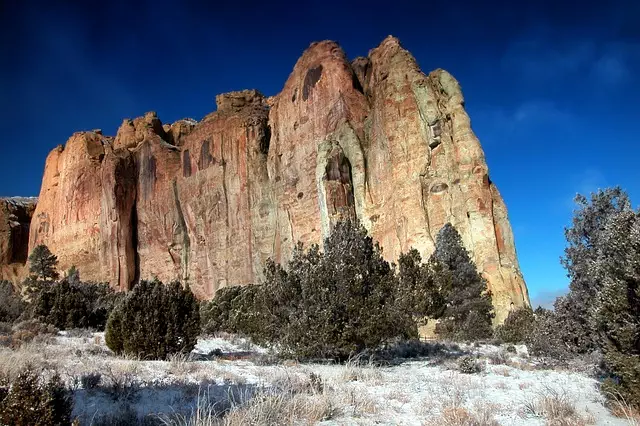Exploring New Mexico's historic districts through a New Mexico travel guide reveals a rich tapestry of cultural heritage and landscapes. Santa Fe's iconic adobe architecture and central plaza are highlighted as key destinations for understanding the state's Spanish colonial, Native American, and frontier legacies. Taos Pueblo, another UNESCO World Heritage Site, offers insight into Native traditions against the backdrop of the Sangre de Cristo Mountains. Las Trampas historic district showcases a collection of 18th-century churches that reflect the region's Spanish colonial legacy. These districts are not just historical sites but active communities where ancestral traditions continue to thrive. For those looking for things to do in New Mexico, visiting these areas offers an immersive experience into New Mexico's complex cultural identity and is essential for a comprehensive understanding of its multifaceted history. Travelers will find a wealth of activities across the state's best places to visit in New Mexico, including Santa Fe, Taos, and beyond, all of which are celebrated in a thorough New Mexico travel guide. These historic enclaves provide an authentic New Mexican experience, making them indispensable for any travel itinerary within the state.
Embark on a historical journey through New Mexico’s enchanting landscapes, where adobe architecture and vibrant cultures converge. Our comprehensive guide illuminates the state’s rich tapestry of history, focusing on its distinctive historic districts. Whether you’re a traveler seeking the best places to visit in New Mexico or a local curious about your region’s heritage, this article serves as a New Mexico travel guide, offering insights into the most preserved and culturally significant areas. Discover the charm and allure of these timeless destinations as we explore the top historic districts that you simply can’t miss. From Taos to Santa Fe, uncover the stories etched in stone and the traditions kept alive in New Mexico’s open-air museums—a testament to the enduring legacy of its inhabitants.
- Exploring New Mexico's Rich History: A Guide to Its Historic Districts
- The Cultural Heart of New Mexico: Top Historic Districts You Can't Miss
- New Mexico Travel Guide: Uncovering the Charm of Historic Districts
- A Journey Through Time: Best Preserved Historic Districts in New Mexico
- From Taos to Santa Fe: A Roundup of Must-Visit Historic Sites in New Mexico
Exploring New Mexico's Rich History: A Guide to Its Historic Districts

New Mexico’s historic districts stand as a testament to the state’s multifaceted history, blending indigenous heritage with Spanish colonial influences and American frontier culture. For those seeking a deeper understanding of New Mexico’s rich tapestry through a New Mexico travel guide, delving into its historic districts is an enriching endeavor. Santa Fe, the capital city, boasts the oldest continuously occupied community in America, offering visitors a glimpse into the lives of its early inhabitants. The Santa Fe Plaza serves as the heart of the city’s historic district, surrounded by adobe buildings that hark back to its Spanish and Native American roots.
Travelers can extend their exploration beyond Santa Fe to other designated historic districts, each with unique stories to tell. Taos Pueblo, a UNESCO World Heritage Site, is one of the oldest inhabited communities in the United States. In contrast, Las Golondrinas in Santa Barbara offers a view into the Spanish colonial way of life. Meanwhile, the Historic District in downtown Albuquerque showcases the city’s evolution with its Pueblo Revival architecture and vibrant cultural festivals. For those looking for the best places to visit in New Mexico, these historic districts are not just relics of the past but living communities where traditions continue to thrive. To fully appreciate the state’s heritage, a New Mexico travel guide would recommend including these historic locales in your itinerary, as they offer a myriad of things to do in New Mexico that cater to history enthusiasts and casual visitors alike.
The Cultural Heart of New Mexico: Top Historic Districts You Can't Miss

Embarking on a journey through New Mexico’s storied past, travelers are beckoned to explore its rich cultural tapestry via the state’s historic districts. These locales, each with their own unique allure, offer a window into the diverse history that has shaped New Mexico. For those consulting a New Mexico travel guide, the historic districts stand out as top attractions among the best places to visit in New Mexico, providing a wealth of activities for history enthusiasts and casual visitors alike.
Santa Fe’s historic district, with its adobe architecture and Pueblo-style buildings, is a living museum that encapsulates the essence of New Mexican heritage. Wandering through its narrow streets lined with galleries, markets, and restaurants, one can feel transported back in time. In nearby Taos, the historic district complements the natural beauty of the Sangre de Cristo Mountains with its own blend of Spanish Colonial and Native American influences. Meanwhile, the town of Las Trampas boasts a collection of well-preserved 18th-century churches that are a testament to the area’s Spanish colonial history. These districts, each with their own stories to tell, are integral to understanding the state’s multifaceted cultural identity and are must-visit destinations for any New Mexico travel itinerary. Whether you’re seeking the best places to visit in New Mexico or simply looking for things to do in New Mexico that offer a deeper connection with the land and its people, these historic districts promise an enriching experience.
New Mexico Travel Guide: Uncovering the Charm of Historic Districts

Embarking on a journey through New Mexico reveals a rich tapestry of history, culture, and natural beauty. A New Mexico travel guide is incomplete without highlighting its historic districts, which stand as testaments to the state’s storied past. These neighborhoods offer a window into the diverse heritage that has shaped the region. From the adobe architecture of Santa Fe, recognized as one of the best places to visit in New Mexico for its Pueblo-style buildings and vibrant art scene, to the well-preserved 19th-century streets of Taos, each district tells a unique story. Travelers can immerse themselves in the charm of bygone eras through the state’s historic sites, which are not just relics but active communities where traditions and histories are preserved. Exploring these districts, one can indulge in a variety of things to do in New Mexico, from visiting iconic landmarks and museums to sampling regional cuisine and engaging with local artisans. Whether it’s the history buff or the culture enthusiast, New Mexico’s historic districts offer an enriching experience that encapsulates the essence of the state’s rich heritage.
A Journey Through Time: Best Preserved Historic Districts in New Mexico

Embark on a journey through time as you explore the best-preserved historic districts in New Mexico, where every street corner and adobe structure tells a story of the past. As a traveler with an interest in history and culture, New Mexico’s historic sites offer a unique blend of Spanish colonial, Native American, and frontier heritage. A visit to Santa Fe, for instance, not only provides a glimpse into the state’s Puebloan roots but also showcases its status as one of the oldest capital cities in the United States. The Santa Fe Plaza, with its vibrant markets and historic buildings, is a focal point for those following the New Mexico travel guide, seeking the best places to visit in New Mexico. History buffs will delight in the adobe architecture that lines the plaza, a testament to the enduring legacy of the region’s early inhabitants.
Further along your New Mexico adventure, the historic district in Taos invites you to experience its rich cultural tapestry, where the influence of the Taos Pueblo and other indigenous communities is deeply embedded in the local culture. From the 18th-century San Francisco de Asís Church, known as the “Roller Coaster Church” for its undulating adobe walls, to the many art galleries that celebrate contemporary and traditional Native American artwork, Taos offers a wealth of things to do in New Mexico for those with an appreciation for history and the arts. Each historic district in New Mexico is not just a relic of the past but a living, breathing entity where tradition and modernity coexist harmoniously. Whether you’re strolling through the streets of Old Town Albuquerque or visiting the various landmarks in Las Cruces, New Mexico’s historic districts are sure to enchant and inform every traveler who steps into their realm.
From Taos to Santa Fe: A Roundup of Must-Visit Historic Sites in New Mexico

New Mexico’s historic districts offer a window into the state’s rich cultural heritage, which spans centuries and is as diverse as its landscapes. From Taos to Santa Fe, travelers can immerse themselves in the state’s past by visiting some of the best-preserved historical sites. In Taos, for instance, the Taos Pueblo, a UNESCO World Heritage Site, stands as one of the oldest continuously inhabited communities in the United States, offering visitors a glimpse into the lives and traditions of its Native inhabitants. Further north, the historic district of Las Trampas showcases a well-preserved collection of adobe churches and the San Miguel Mission, which dates back to 1610.
Moving south towards Santa Fe, the city’s Plaza is a National Historic Landmark, serving as the heart of New Mexico’s capital since its founding in 1610. The surrounding area is dotted with over 250 adobe structures that tell tales of Spanish colonial architecture, Puebloan traditions, and Anglo-American influences. History buffs and casual visitors alike will find no shortage of things to do in New Mexico within these historic enclaves, from exploring the Loretto Chapel’s mysterious spiral staircase to admiring the intricate murals at the Palace of the Governors. A visit to these sites is a must for anyone consulting a New Mexico travel guide looking for the best places to visit in New Mexico, as each location provides a unique and enriching experience into the state’s storied past.
